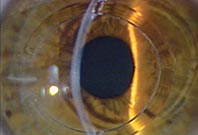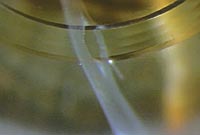Intacs for keratoconus show safety, stability in the long term
Vision improved in more than 70% of patients, and the segments may have a role in stabilizing the progression of ectasia.
ROME – Long-term evaluation of the efficacy of Addition Technologies’ Intacs intrastromal corneal ring segments as a treatment for keratoconus showed that most patients have had an improvement in their vision, and the results appear to be stable over time.
These results were presented by Joseph Colin, MD, at the European Society of Cataract and Refractive Surgeons Winter Refractive Surgery Meeting.
Dr. Colin’s study included 100 consecutive eyes of 82 patients with keratoconus and intolerance to contact lenses who had been referred to Bordeaux University Hospital in France for penetrating keratoplasty.
“Intacs implantation is a less invasive approach to keratoconus, which is worth trying when the cornea is still transparent,” he said. “The inserts reshape the keratoconic cornea by lifting the inferior ectasia and flattening the tissue, thus decreasing the asymmetric astigmatism. The central cornea remains untouched, and no tissue is removed. The procedure is perfectly reversible, and the Intacs can be explanted or exchanged without any problems.”
An easy procedure
In all patients, surgery was performed without any intraoperative complications, Prof. Colin said. Two segments were inserted in the cornea through a temporal incision into two manually created symmetrical channels, one superior and one inferior. The tunnels were placed at approximately two-thirds of the corneal depth. Initially, segments of different thickness were used superiorly and inferiorly in an attempt to better compensate for the irregularity of the corneas.
|
Images: Colin J |
“The implantation procedure is fairly easy,” Prof. Colin said. “Later developments have proposed the use of femtosecond laser to perform the channels. Although this makes dissection easier and faster, the implantation of the segments is more cumbersome, because the laser creates some bridges of tissue inside the tunnel, and you have to push harder than in a manual procedure.”
Encouraging results
In two eyes, the Intacs were removed after 5 and 8 months because of the extrusion of one segment at the incision site, Prof. Colin said. Segments were removed from two eyes for poor visual outcome, and penetrating keratoplasty performed.
“It is important to inform the patients that the treatment might fail in a small percentage of cases. However, they shouldn’t be discouraged from trying since the procedure is minimally invasive and easily reversible, ” he said.
In the remaining 82 eyes, results at 1 and 2 years showed a statistically significant improvement of refraction. Mean cylinder was reduced by about 1 D, and the effect of the treatment progressively continued between 1 and 2 years. The manifest refraction spherical equivalent (MRSE) improved by more than 1 D in 70% of the cases.
Almost 70% of the eyes gained one or more lines of uncorrected and best corrected visual acuity, but in some cases (5% to 12%) there was a loss of one line or more of acuity.
For Your Information:
- Joseph Colin, MD, can be reached at Hôpital Pellegrin, Place Amélie Raba-Lèon, 33076 Bordeaux, France; +33-5-56-79-56-08. Prof. Colin has no direct financial interest in the products mentioned in this article, nor is he a paid consultant for any companies mentioned.
- Michela Cimberle is an OSN Correspondent based in Treviso, Italy.


